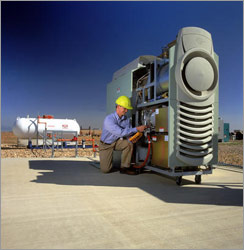microturbine

Engineer servicing a Capstone microturbine.
A microturbine is a very small turbine, fueled by natural gas, wind (see micro wind turbine), or some other energy source, that generates electricity for use in homes or commercial establishments.
Combustion microturbines, which run on fuels such as natural gas, hydrogen, propane, or diesel, typically produce between 25 kW and 500 kW of power. They were derived from turbocharger technologies found in large trucks or the turbines in aircraft auxiliary power units (APUs). Most combustion microturbines are single-stage, radial flow devices with high rotating speeds of 90,000 to 120,000 revolutions per minute. However, a few manufacturers have developed alternative systems with multiple stages and/or lower rotation speeds. Combustion microturbine generators can be divided in two general classes:
While some early product introductions have featured unrecuperated designs, the bulk of developers' efforts are focused on recuperated systems. The recuperator recovers heat from the exhaust gas in order to boost the temperature of the air stream supplied to the combustor. Further exhaust heat recovery can be used in a cogeneration configuration.
